#1993-1995: the early years
Text
They're PEN PALS? :D
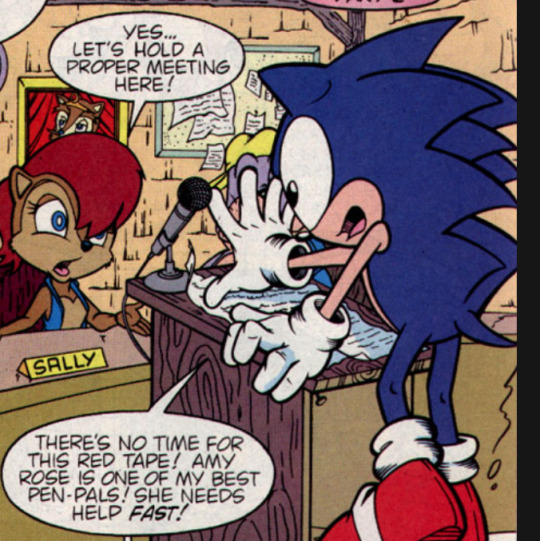
#Sonic the Hedgehog#Sonic Archie#1993-1995: the early years#Sonic the hedgehog comic#Sonic the hedgehog 25#Amy Rose#Sonic
35 notes
·
View notes
Text
Now the question is: did his father died before he turned 4 or after he turned 3
#Tokyo revengers timeline questions#was it late 1993 or early 1994#ill go with 'just turned 3' because with his brother turning 13 itll work with the 'dads dead started his teenhood/middle school year'#ok yeah shinichiro started delinquency in 1993 and BD in 1995
2 notes
·
View notes
Text
Through my public school education in the '90s and early '00s, our US history classes always ran out of time at the end of the year, somewhere around the '60s civil rights movement. We usually had enough time for a rushed, incomplete, confusing explanation of the Vietnam War. We never learned about Watergate or the fall of the Berlin Wall or Reagonomics or the Gulf War. They were in our history books, but we never got to that part.
It terrifies me to wonder what era history classes end on now. Do they make it past the Cold War era now? Past 9/11 and the War on Terror? Or are young folks today entirely uneducated on the horrific Islamophobia and civilian slaughter that occurred at the beginning of this millennium?
2K notes
·
View notes
Text
An argument I hear from time to time is the following:
"I don't care that this novel is considered Legends, if it was canon when George Lucas was in charge of Lucasfilm, it's still canon to me now. Whatever George says is what counts, I don't care what Disney says."
Putting the Expanded Universe's Star Wars and George Lucas' Star Wars in the same basket. And that's, uh... inaccurate.
So without further ado, let's explore:

George Lucas’ involvement in the Expanded Universe
Early years of the EU...
When the first bit of EU content came out in the form of the novel Splinter of the Mind's Eye, Lucas was too busy working on the films, so Alan Dean Foster wrote it by himself (which explains why Luke and Leia's relationship plays out romantically).
After the movies came out, when new material was going to be created, George told Lucas Licensing and other authors that the Prequel era was off-limits to write about, because he might tell that story one day.
Beyond that, they could go to town and write sequels, for instance. After all, part of why Star Wars was created was to let people's imagination run wild and George was happy to let other artists play in the sandbox he created.
That said, things were very clear from the get-go.
These weren't his stories.
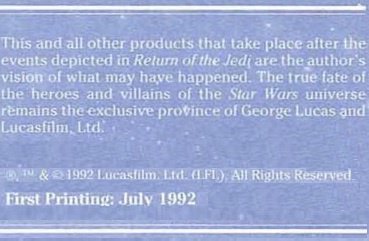
The Thrawn books, Dark Empire, all this material was explicitly just Tom Veitch and Timothy Zahn and whoever else's creation. Not George's, who was described by Lucas Licensing's Lucy Autrey Wilson as "not very involved".
The most he did was answers "OK/Not OK" questionnaires about what the EU writers could or couldn't write.
Telling Yoda's backstory? Not OK.
Telling Han's backstory, between the Prequel and Ep. 4? OK.
Having someone wear Vader's suit after his death? Not OK.
The Emperor returning in a clone body? OK.
So that's it. That was his involvement in the 90s.
Him saying "don't write something set during this/that period".
"OK/Not OK" questionnaires.
It's also worth mentioning he didn't approve of Mara Jade, Luke's wife in the EU. In his mind, "Jedi don't marry".

Rather, the character herself wasn't an issue... until she married Luke. When Timothy Zahn asked for Luke and Mara to be married or engaged, back in 1993, Lucasfilm initially vetoed the idea.
According to Brian Jay Jones (author of "A Life", George Lucas' biography), in 1995 George convened a 'Star Wars Summit' wherein he gathered licensees and international agents to Skywalker Ranch to reinforce "the need for him to maintain quality control, especially in the areas of publishing, where some characters—such as Luke Skywalker, who’d been given a love interest in a fiery smuggler named Mara Jade—were living lives far beyond the ones he had written for them in the original trilogy".
Sources:
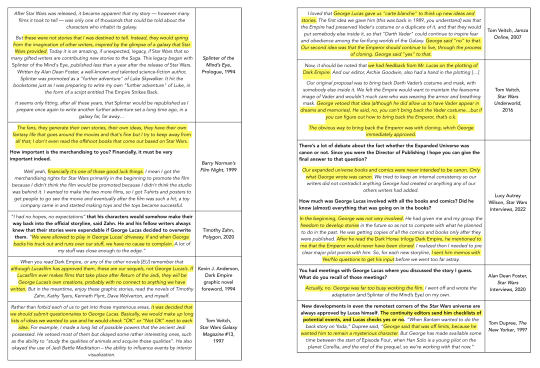
During the Prequels...
George Lucas was writing and directing three movies with large themes, shot almost back-to-back, commuting between Australia and California. That's hard enough as it is.
Also, in the 90s, most movies were still shot on film. During the making of Phantom Menace, Lucas shot parts of the film by combining prototype digital Sony cameras and using them in combination with videotapes, rather than shooting on film.
For Attack of the Clones, George worked with Panavision and Sony to develop fully digital cameras, which eventually became the standard.
As if that wasn't enough, by making the Prequels, Lucas and ILM were also creating fully-digitized worlds (Coruscant, Geonosis) and characters (Jar Jar, Yoda) and laying the groundwork for the CGI technology that has now become essential for today's blockbusters.
Having established all this...
Do you really think he had the time or the patience to read through a bunch of novels and guidebooks?!
Simply put: George Lucas was too busy revolutionizing cinema to be involved in the development of the EU.
So if you ask George who Tahl or Vitiate are, or what the Stark Hyperspace War or a vapor manifold are, if you ask him to recite you the Sith Code... he'll grumble and say "heck if I know".
He outright admitted that fans know more Star Wars lore than him.
Because SOMEBODY ELSE wrote that stuff.
And he let them do it because:
It made money. A lot of money, especially after TPM came out. Money that could fund his next films. You don't mess with licensing. Hell, it's why he was so cool with there being all those Star Wars parodies.
He didn't see those stories as canon anyway, so it couldn't hurt. He saw them as a separate universe, an alternate timeline wherein the films happened ALONG with all these other tales.
So associating the EU content with Lucas is unreasonable. He was too busy, so he just let Howard Roffman, Lucy Autrey Wilson, Sue Rostoni and Lucas Licensing do their thing and crank out new stories and transmedia content for the fans.
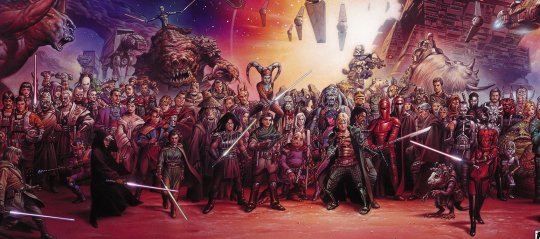
It was a one-way relationship. The licensing parallel universe needed to have some internal consistency AND adhere to what Lucas established in the new films movies (which was difficult because they weren't involved in the production process), but he didn't need to be in line or consistent with anything they established.
Now, George did set some guidelines/boundaries and there were obviously do's and don'ts. But once those boundaries were set and the brief was established, the authors had a lot of freedom and, like, 99% of their interaction was with their editors from the respective publishing houses (Scholastic, Del Rey, Dark Horse) and the folks at Lucas Licensing.
George was only really brought in to sign off on, like, some of the major plot points only once in a blue moon. Stuff like:
"Let's make a Maul novel".
George would go "fine, just keep him mysterious."
"What species should Plagueis be?"
George: "he could be a Muun, here's concept art."
Nothing more than that. Again: the Expanded Universe was other storyteller's interpretation of what Lucas had created.
Sometimes, it was spot on and it aligned with George's vision.
Other times, this additional lore was created by writers who didn't know what he was doing with the Prequels, so they were in the dark regarding certain plot points.
And then you have the authors who absolutely disagreed with George's vision of the Prequels, or of Star Wars, in general, but wanted to engage with the material nonetheless.
Which is why, whilst sometimes the EU fixed some plot-holes, sometimes the EU had inconsistencies.
Inconsistencies such as Ki-Adi Mundi being a Knight on the Council, who is married and has kids (when the Jedi being prohibited from marrying is a major plot point in the Prequels)...
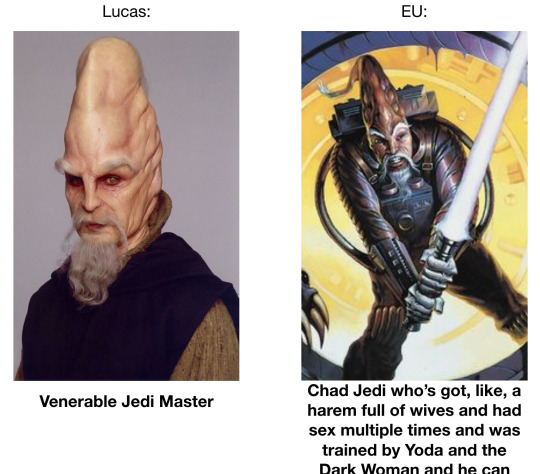
… or the Jedi being essentially superhuman (when one of the narrative reasons Qui-Gon is killed is to show that the Jedi are mortals, not supermen)…
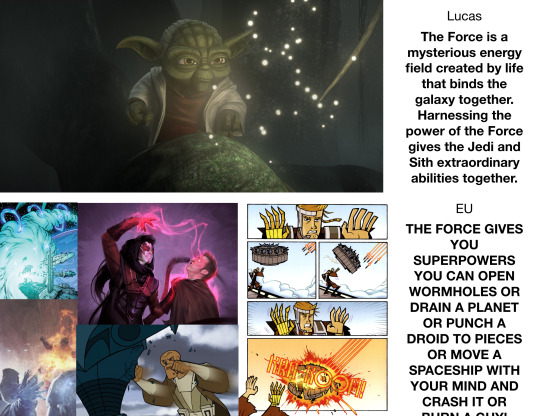
... or other stuff like Mace having a blue lightsaber for a period (because who the hell knew purple was an option?!) or some Jedi having red lightsabers, or Sith Lords being able to become ghosts after death, when that's a feat you can only achieve by being selfless.
It's also why you get conflicting definitions of what the Jedi call "attachment" or conflicting narratives trying to reframe midi-chlorians as a cold, intentionally-flawed way of seeing the Force (when they're meant to be a beautiful metaphor for symbiosis and how the Force works).
And it makes sense that some of this stuff wouldn't track, considering how Lucas stated multiple times that he didn't have anything to do with it, that it was a separate universe from his own...

Safe to say that if George had any involvement in the EU, it was so minimal that he, himself, didn't count it as "involvement".
Additional sources:
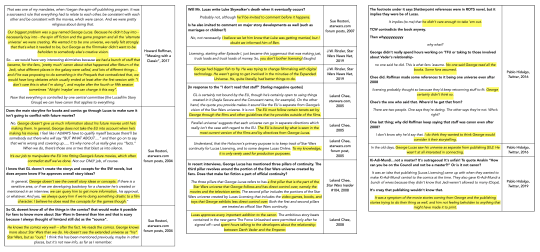
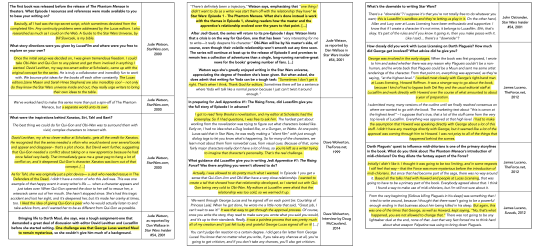
Later years of the EU...
After the Prequels were over and done with, Lucas created The Clone Wars with Dave Filoni. At first, he'd just suggest a few storylines, but he quickly got VERY involved in the whole process. Far more involved than he ever was with EU content.

And y'know... Dave Filoni is a massive Star Wars fan and an avid EU reader. So, from time to time, Filoni would bring up EU material for Lucas to consider during the story conferences, and they'd look at what was out there together.
But it's important to note that George's stance toward the EU didn't change and became a rule for everyone on the writing staff: the EU content was nothing more than a pool of "fun what-if ideas" that they could draw inspiration from.
If they could, they'd try to not mess with continuity... but if the story called for it, they could retcon anything without batting an eye. Because it wasn't canon to them.
It's why author Karen Traviss quit working with Lucasfilm after the Mandalorians were retconned into pacifists in The Clone Wars.
youtube
The only things that were truly canon were:
George Lucas' own word.
The movies.
Previously established The Clone Wars lore.
And that's it.
Everything else was somebody's else's concern. Not George's.
Sources:



This way of seeing the EU continued all the way to the time shortly before George sold the company to Disney as his drafts for the Sequels featured:
no Jacen, Jaina or Anakin Solo (Han and Leia's kids from the EU),
a still-alive Chewbacca (who died, later in the EU),
no "New Jedi Order".

Every version of George's Sequels ignored the EU.
Which would explain why the EU reboot was planned in the summer of 2012 (when Lucas was in charge)!
I'll repeat: the EU reboot was planned months BEFORE George Lucas sold the company to Disney.
Because of course it was! It's a natural result of 30 years' worth of content that's so intermeshed that it would stop future artists - namely George himself - from creating anything else.
Sources:
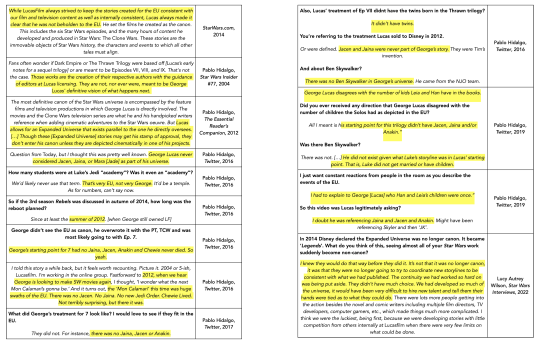
Exceptions to the rule:
1. Comics (kinda)
He did read the comics. Or at least, he gave them a glance.
Aside from the fact that he grew up reading comics, understand that George Lucas is a visual artist, first and foremost.
That's what he's about and that's what he loves, that's what speaks to him. There's a reason his upcoming Museum of Narrative Art will feature comic panels and pages of all kind.
During pre-production on Attack of the Clones and Revenge of the Sith, Lucas had the art team draw concept art before a script had ever been written so he'd have ideas for set-pieces.

Later on, J.W. Rinzler pitched him the idea of adapting his early drafts for Star Wars into comic form. Lucas' initial reaction was going "hell no". Rinzler had concept art made…
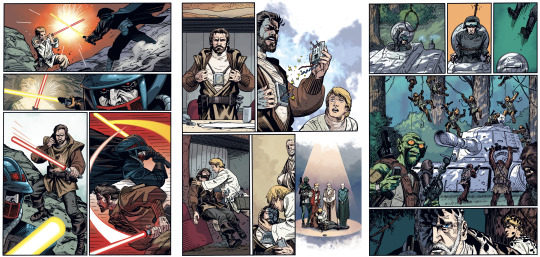
… and George took one look and was on board.
So it's not a stretch to assume that a book telling a story through beautiful drawings would catch his attention more than a novel.
Case in point: He knew who Quinlan Vos was and was enamored with the character. He knew Aayla enough to put her in Attack of the Clones after seeing a cover of Republic by John Forster featuring her (below, left).
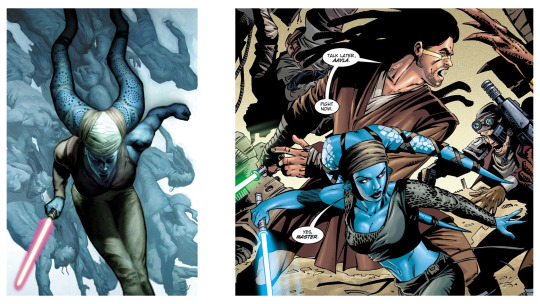
(although, it's worth pointing out that he doesn't call her out by name a single time, in the director's commentary of the Attack of the Clones, she's just the "Twi'Lek Jedi" and her inclusion was done mainly to add more diversity to the Jedi fighting in the arena)
Over a decade later, when the comic Star Wars #7 came out in 2015, Lucasfilm acquired artist Simone Bianchi's original 20 pages and cover art for George, so he could feature it in his the Museum of Narrative Art:

So at the very least, he looked at the comics and admired the visuals.
Whether he actually read the comics in detail or just skimmed through most of them because he liked the pretty pictures (likelier, imo) is an entirely different matter.
Sources:

2. Video-Games (kinda)
Lucas would periodically check in on the status of LucasArts games, lending creative input and advice.
Sometimes, his advice ranged from "weird" to "he's gotta be fucking with us, right?"
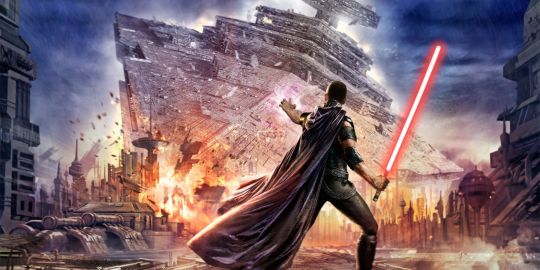
Apparently, he advised the team developing Star Wars: The Force Unleashed that they dub Starkiller "Darth Insanius" or "Darth Icky".
And you know what? I have no trouble believing it.
Firstly because if you're going by the idea that he gave no fucks about the EU, then of course he'll come up with "meh" names. But also, this is the same guy who created "Winkie" in 2012/2013, the character who'd go on to be named "Rey".

He also told the team creating Star Wars: 1313 that he wanted a fresh face as the main character, then only weeks before the game was announced he went "let's make it Boba Fett".
Finally... the cancelled Darth Maul game by Red Fly.
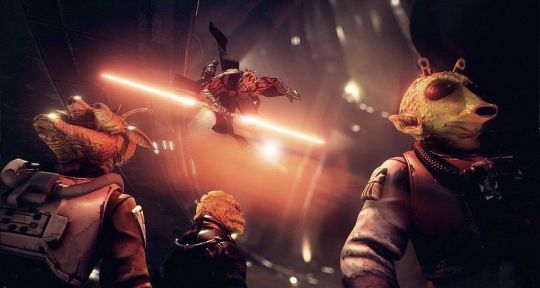
Codenamed “Damage”, then “Battle of the Sith Lords”. Think Batman: Arkham City meets Star Wars.
Red Fly pitched it as a coming of age story where we see Maul be kidnapped, tortured, eventually joining the Dark Side, and ending in TPM. Then they had interactions with LucasArts and found out Maul survived his fight with Obi-Wan.
The game went through several iterations, partly because the people at Red Fly were kept in the dark about the developments in The Clone Wars (Season 4 wasn't out yet), and even when some tidbits came out and they knew characters like Savage Oppress and Death Watch would be included, they didn't get more details.
youtube
Whatever. They do their best to make something from what they're told. Then they have a meeting with George. As this GameInformer article explains:
“A friendly George Lucas entered the room and was eager to hear the pitch from Red Fly’s creatives. “Before they could finish their spiel, Lucas cut them off, stood up, walked over to [two Sideshow Collectibles statues of Darth Maul and Darth Talon], rotated them to be facing the same direction, pushed them together, and said ‘They’re friends!’” adds the source. “He wanted these characters to be friends, and to play off of each other. […]
The problem with the idea of Maul and Talon teaming up for a buddy cop-like experience was that they were separated by over 170 years […]
When this vast time divide was brought up to Lucas’ attention, he brushed off the notion of it not working, and said that it could instead be a descendant of Darth Maul or a clone of him.”
So now the game is about a descendant of Maul, guided by his ancestor and fighting a redesigned Darth Krayt, etc?
The game was eventually cancelled when George sold the company.
Worth pointing out that this was circa 2010/2011... around the time that George started working on his Sequels, according to Jett Lucas. And we know that the treatment for the Sequels that Lucas presented to Bob Iger featured old man Maul and Darth Talon as the villains of the trilogy... take from that what you will.
3. The Prequel novelizations (kinda)
They were all given a copy of Lucas' screenplay.
While most of their work was with Sue Rostoni, Lucy Autrey Wilson, and Howard Roffman on the Lucasfilm team (like some of the other authors), Terry Brooks, R.A. Salvatore and Matthew Stover all spent a bit of time with George before writing their respective novels.
George told Terry Brooks to write some additional material for Anakin Skywalker because there wasn't enough of that in the movie. He was shown rushes from the set, they "opened the safe" for him. When Terry had further questions re: midi-chlorians and the history of the Sith, George goes on a 30-minute monologue about all that.
R.A. Salvatore had a 45-minute interview with him that turned into a 3-hour chat. He was able to go back to the Ranch a few times during the writing process, and one of those times George chatted with him and his wife during lunch. He was shown various cuts of the film and concept art.
Matthew Stover and George talked for a whole afternoon (I'm gonna go out on a limb and assume he was also shown the other stuff like some cuts/deleted scenes, concept art, etc etc).
Was there a line-edit of the ROTS novel from Lucas?
Regarding the Revenge of the Sith novelization, some people bring up the idea that George Lucas did a line-edit on the book because Stover wrote this statement on theforce.net:
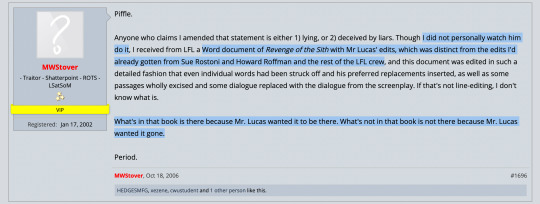
That said...
Stover, also stated that Lucas told him to write whatever he wanted as long as it was good,
he also said he didn't actually see Lucas type the edits,
an anonymous Del Rey editor stated on theforce.net that the notion that George edited the novel himself is "extremely incorrect".

There's enough "reasonable doubt" for the argument to be made that the Revenge of the Sith novelization was edited the same way as any other Star Wars novel, rather than by George himself.
The fact remains, though, that it was a novel written by someone who understood the source material, as it was explained to him in detail by George Lucas himself (a luxury many SW authors never got).
Lucas' backstory for the Sith in the TPM novel:
If Pablo Hidalgo is to be believed, the backstory of the Sith, as detailed in the Phantom Menace novelization, came from Lucas.
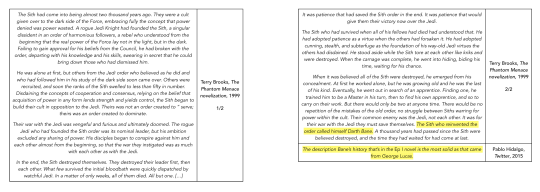
(Obviously, I'd allow for the very likely possibility that there was some embellishment by Terry Brooks)
20 years later, however, it seems George decided to stick to the idea that there was no war between the Jedi and the Sith.

Final thought:
A lot of people will insist that George was involved in spite of all the above-posted evidence. Saying stuff like:
"But [X person] said that it was canon..."
Sometimes, they’ll link you to this whole website collecting quotes of other people saying "the EU was canon" (never George Lucas except for, like, one/two quotes where he acknowledges the existence of Sequel books which MUST mean he saw them as canon, right?) and...
On the one hand... of course they'll all vaguely say he's "involved" and tip-toe around the subject; it's technically true and, again, they're trying to make money. It's a business, folks.
On the other... yeah? Duh. Of course it was canon to Lucas Licensing and the authors who wrote for the EU. But it wasn't canon to George. And I just gave you a whole bunch of quotes directly from him and/or the same people quoted on that website, all confirming that he didn't see them as canon and he wasn't involved (or barely was).
Other times, we're straight-up approaching "burying head in the sand/lalalala I'm not listening!" levels of justifications.
Like, we just talked about the Sith's origins, right?
I remember a while ago, this Star Wars YouTuber was reviewing this quote from Lucas, in The Star Wars Archives: 1999-1995:

The YouTuber's reaction the second after reading the quote is saying:
"And of course, what George is referring to, here, is the Battle of Ruusan and the Brotherhood of Darkness using the Thought Bomb created by Lord Khan to kill the Jedi Lord Hoth and…"
My guy! You read a whole excerpt that started with "there was never a war between the Jedi and the Sith" and the words "Ruusan" or "Thought Bomb" never being mentioned once in the passage (or in the TPM novelization)... and concluded that George was referring to the Jedi/Sith Battle of Ruusan? And all that other EU stuff?
See what I mean, folks?
Now, look, I grew up with these stories (heck, I grew up with these stories in three different languages). So I get it. I know they're awesome.
And, yes, there is a difference between the kind of content we used to get and the content we're getting now (for one, lightsabers used to be lightsabers, in video-games, not baseball bats).
But if you're trying to prop up the EU, the facts show that the "George Lucas signed off on them" authority argument isn't a valid one. Because he clearly wasn't very interested or involved in it.
And why would you want to use this authority argument, anyway?
You shouldn't need to say "this came from Lucas" to like those stories. They don't need to be George Lucas Approved™ to matter and to be validated as "worthy of appreciation". They're valid on their own, they're great stories. And if you like them better than the Sequels, go to town. I know I do.
The only thing you can't do (with a straight face, at least) is hold them up as "the True Lucas-Approved Canon™ as opposed to the Disney Trash" in a rant, because you'd be wrong and/or lying. Neither had Lucas' hand in them in any meaningful way.
Finally... I was devastated when the EU was officially made non-canon, in 2014. And for a few years, I saw the new Star Wars continuity through this lens:
"Any EU content is still canon unless it's directly retconned...!"
Trust me, when I say that only pain lies that way. Because that's not how a lot of Star Wars creators, including the Flanelled One himself, see it. The way they saw/see it is:
"Unless it's been shown in a movie or TCW... it's a legend, it might have happened."
This line of thought seems to be increasingly applied to the new Disney canon too, by the way. "If it's not shown on a screen, then it's probably canon yet also up for grabs to be retconned."
And the sooner you accept that this is how it's being treated, the sooner you accept that the EU was never canon to Lucas or Filoni...
... the less painful it'll be when, I dunno, you watch The Acolyte and it's nothing like the Darth Plagueis novel or Plagueis himself is absent, or he's there, but as an Ithorian instead of a Muun.

(note how I didn't use the word "painless")
#Lucas Canon & EU Canon & Disney Canon are all different things.#the only downside to this notion is that you can't use Lucas' name in conjunction with the EU to win a debate or rant about LF.#or use Lucas' name to validate a headcanon that came from the EU#Aside from being glad he got to create a universe that inspired so many artists and creators to let their imagination go wild#he barely gave a crap about what other writers did in a parallel universe that he didn't even see as canon.#and that's FINE#collection of quotes#89 quotes I think#this may be the longest or second post I've written yet#meta#sw meta#expanded universe#george lucas#lucas quotes#dave filoni#youtube#star wars#star wars analysis#TCW#star wars comics#star wars novels#lucasfilm#EU#Legends#star wars legends#sw legends#supplementary material#long post
848 notes
·
View notes
Photo
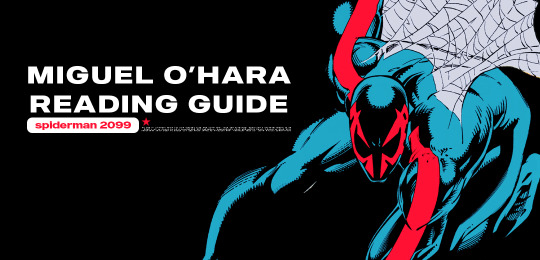
spider-man 2099 / miguel o’hara reading guide
miguel o’hara was a young genetics genius employed at mega corporation alchemax, in the future city of nueva york of the year 2099 (a future universe where all superheroes got wiped out). he became spider-man when one of his experiments to replicate the powers of spider-man is used against him, his dna is rewritten and became fifty percent spider.
essential reading:
spider-man 2099 (1992), #1-10
spider-man 2099, #11-14
spider-man 2099 annual, #1
2099 unlimited #1-3 *
spider-man 2099, #15
ravage 2099, #15 *
x-men 2099, #5 *
doom 2099 (1993), #14 *
punisher 2099 (1993), #13 *
spider-man 2099, #16-22
spider-man 2099, #23-33
2099 unlimited #8 *
ghost rider 2099 #7 *
spider-man 2099, #34-38
spider-man 2099 special #1
spider-man 2099 meets spider-man #1
2099 unlimited #9-10 *
spider-man 2099, #39-46 *
2099: world of tomorrow (1996), #1-8 *
2099: manifest destiny *
* in early 1996, editor joey cavalieri was fired. it led to the cancellation of the 2099 titles. for spider-man 2099′s case, peter david (creator and writer) chose to resign in solidarity with his editor, finishing his run with issue #44. the last two issues of spider-man 2099 were done without his input and the series ended with issue #46.
* cross-overs are optional reading, they’re grouped together with the original spider-man 2099 issues because it’s part of their collection.

non-essential reading (crossovers):
fantastic four 2099 (1996), #4, #6, #8
captain marvel (2000) #27-30
exiles (2001-2008), #72 *
exiles #75-99
exiles annual #1
timestorm 2009-2099 (2009), #1–4 *
* exiles!miguel is a variant (not the same from his 1992 run), he’s from earth-6375 here.
* timestorm!miguel is a variant, he’s from earth-96099 here.

semi-essential reading (main marvel universe):
superior spider-man (2013), #17-21
superior spider-man #22-26
superior spider-man annual #1
superior spider-man #27-31
superior spider-man annual #2

essential reading (spider-verse event):
spider-man 2099 (2014) #1-5
amazing spider-man (2014) #1
amazing spider-man (2014) #9-15
spider-man 2099 (2014), #6-12
spider-man 2099 (2015), #1-5
spider-man 2099 (2015), #6-10
spider-man 2099 (2015), #11-16
spider-man 2099 (2015), #17-21
spider-man 2099 (2015), #22-25
spider-man 2099 meets spider-man (1995)
amazing spider-man (2018), #32-36

semi-essential reading (back to 2099):
spider-man 2099 (2019)
spider-man 2099: exodus alpha (2022)
spider-man 2099: exodus #1-5
spider-man 2099: exodus omega
spider-man 2099: dark genesis #1-5

other media:
spider-man: shattered dimensions (2010, video game)
spider-man: edge of time (2011, video game)
ultimate spider-man, the spider-verse: part 1 (2015, animated series)
spider-man: into the spider-verse (2018, film)
spider-man: across the spider-verse (2023, film)

this reading guide will be updated should any upcoming projects arise!
#spidermanedit#comicedit#marveledit#miguel o'hara#spider man 2099#spider man: across the spider verse#atsvedit#*#heavily inspired by coolgirl's jason guide :)#very big thank you to zee (@tresrachas on twt) for the graphics help!
395 notes
·
View notes
Note
Quick question, have we figured out why Richard is so damn ATTRACTIVE??? Like he was so fine during the Mutter and MiG Era but he's even better now??? Sir I have questions!!!! What is it about you that's so addictive??? And that belly??? A MASTERPIECE!!!! He needs to pay for my rehab I'm dying over him at this point lmao
Hi hello how did you get into my head and write down exactly what I think about daily?? Because I'm still so fascinated regarding how he changed over the years, while remaining so enticing and attractive, always reinventing himself a bit, experimenting with different looks and styles while maintaining his overall vibe and aesthetic 😌 This of course includes his physique and wonderful chunkiness, but I'll shamelessly use this ask to venture out in earlier decades, to appreciate this man in all his glory 😩 (I hope that's alright with you)
Let's take a tiny look at Mr. Richard Z. Kruspe over the years, just to process this delicious evolution of his:
Very early on we had a lean Richard with the dreads, for some a no-go, for others quite a charming look (i know exactly i'm not the only one who's down for dreadlock Richard 👀), picture from ca. 1993:

In the beginning of Rammstein, we have some brown and blond haired, somewhat muscly Richard (ca. 1995/1996):


Then of course the ethereal look of Live aus Berlin (recorded in 1998) and his general style during the Sehnsucht era (Viva interview from 1997):

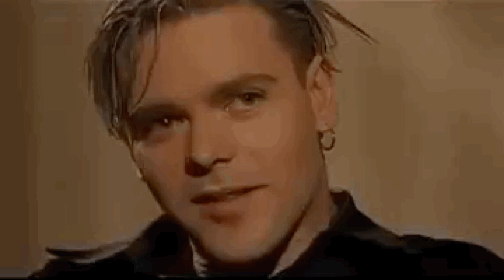
Moving on to the Mutter era, the first time his iconic spiky black hair was introduced to the world (picture from 2001 in Tallinn, gif from 2001 at the Velodrom Berlin):
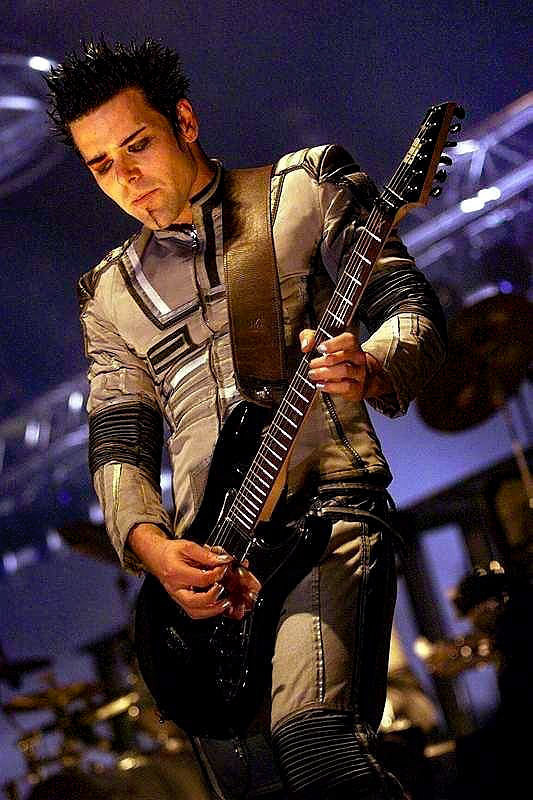
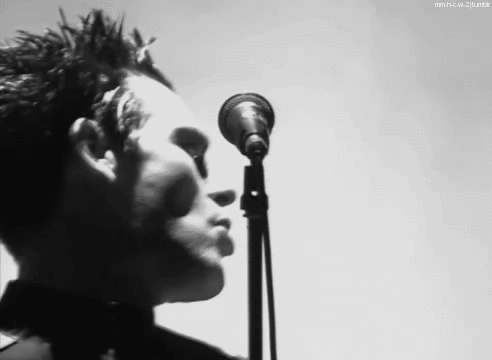
He maintained a similar style and physique (very much toned and gym-trained I guess) or a while, for example during Völkerball (recorded in 2005):
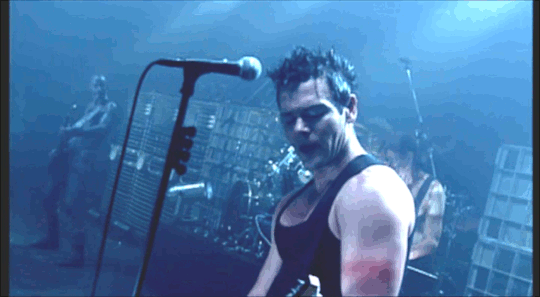
or in various music videos, such as "Mein Teil" (2004) and "Benzin" (2005, albeit with some very much 2000s eyebrows):


In 2009 while LIFAD was released and during the LIFAD tour, he shortly ventured into another hair style (I won't comment, it was.. something, picture of 2009), then again back to the spiky style and tried out the mohawk (picture from 2012 I think), while parts of his typical stage outfit were born plus he's rather muscly here too:


During the festival tour 2016/2017 you can slowly see him becoming a bit broader/meatier in his physique, which I find just absolutely wonderful, plus some combacks like his spiky hair (gifs from an interview in 2018):



And slowly but surely we arrive in the current time and Richard's current style and physique: vampire coat, chicken coat, meaty and chunky Richard in all his glory:


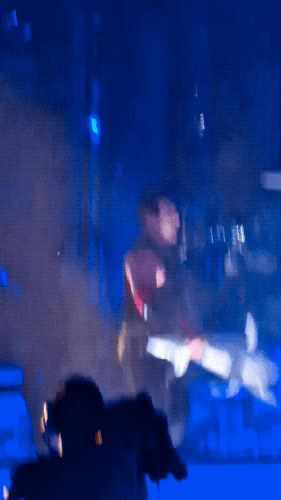

All in all I have to say: It's so interesting to see how he changed and still stayed true to himself and his aesthetic, to his enthusiastic and genuine self while continously trying out new styles. And this includes his physique!! His appearance of course changed over the span of 30 years, that's aging for you. Of course he put on some weight - but that doesn't negate the fact that someone can be unbelievably attractive. And yes, I wholeheartedly agree, his belly now is a master piece, forged by the heavens, a gift from god, just perfection 💖
#WOW ok this took a long time to answer sorry I kind of lost track looking at.. him#this got way out of hand AGAIN#why do i have zero control over me when it comes to answering asks idk why I always go so overboard regarding richard#i'm so sorry for everyone who has to witness this obsession of mine#i promise you i'm kind of normal still#thank you for this ask!!#rammstein#richard kruspe#rzk
78 notes
·
View notes
Text
Jefferson Mappin in 1980s & 1990s.
Jefferson Mappin is a Canadian actor born in Montreal. His film career started in 1978 with a small role in the Canadian/UK crime drama Tomorrow Never Comes starring Oliver Reed and Raymond Burr. I had never heard of him until I saw him in The Freshman a couple of weeks ago. At 6'5" he is always able to find work.

Jefferson Mappin

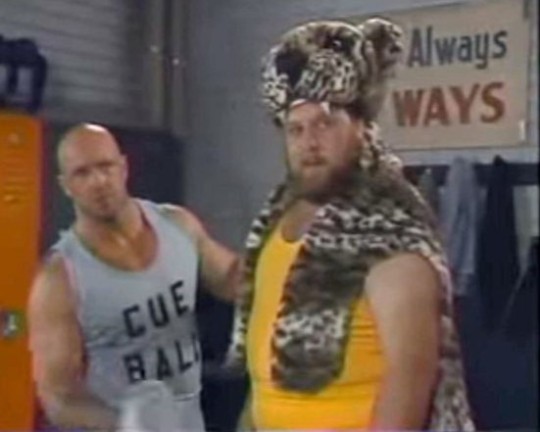
Most of Mappin's early work was in small roles in Canadian films that as of yet haven't been digitalized. The above stills are from the 1988 Canada/US Sitcom about a professional wrestler, Learning the Ropes, starring football player Lyle Alzado and often real professional wrestlers of the time made guest appearances. Only 13 episodes were produced. The first photo was from the pilot episode and it looks like it was from somebody's old VHS home recording. The next photo is a little better. Jefferson Mappin played a wrestler called Cheetah. It isn't known how many episodes he appeared in.

In 1990 Mappin played a pro wrestler again on an episode of the US/Canada crime drama, T and T, starring Mr. T of course.
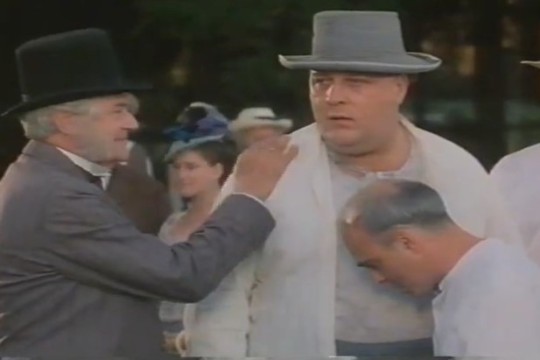
Jefferson Mappin played an insane asylum resident in the film Beautiful Dreamers based on true events in 1990.
The Freshman, 1990, starring Marlon Brando and Matthew Broderick would fit in right here but Jefferson was barely visible in his scene, so I left it out any photo.
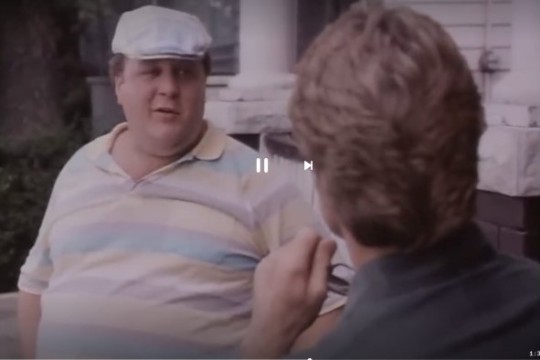

In 1991, Jefferson Mappin plays a real estate agent in the fantasy/drama White Light.
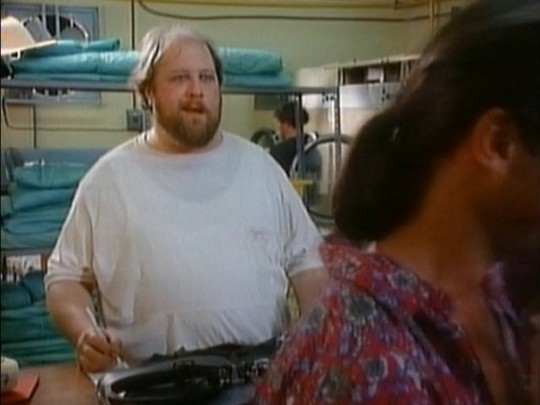

and Mappin as a dry-cleaning employee in an episode of Tropical Heat (nee Sweating Bullets).
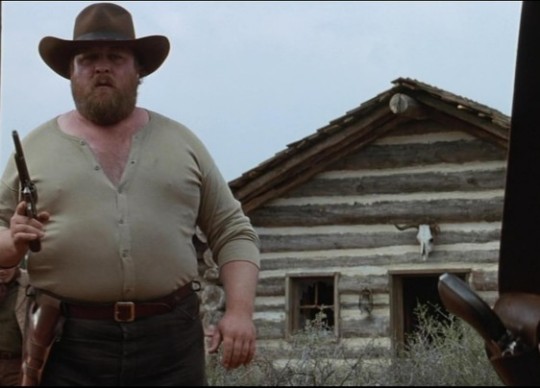
Here is Jefferson Mappin as Fatty Rossiter in 1992 in Clint Eastwood's western, Unforgiven.
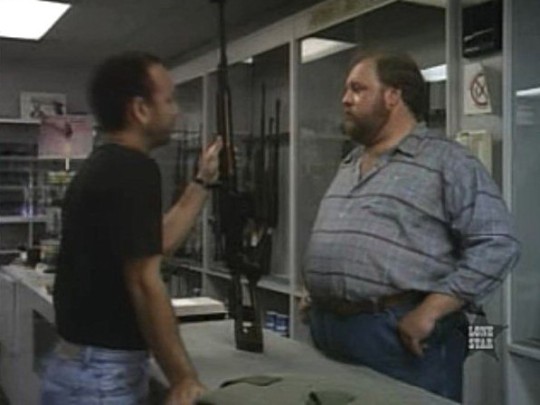

Here is Jefferson Mappin as a gun shop owner being questioned about a gun purchased in an episode of the TV series Counterstrike in 1993. I like the way he is pressed up against the counter.
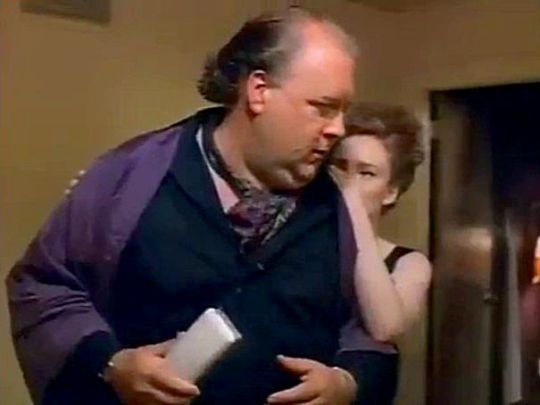
Jefferson Mappin is a suspect responsible for a missing girl and human trafficking in this TV movie Spenser: Ceremony in 1993 made 5 years after the series Spenser for Hire ended.

Jefferson again as a gun shop owner in 1995 in an episode of the comedy/drama Due South.
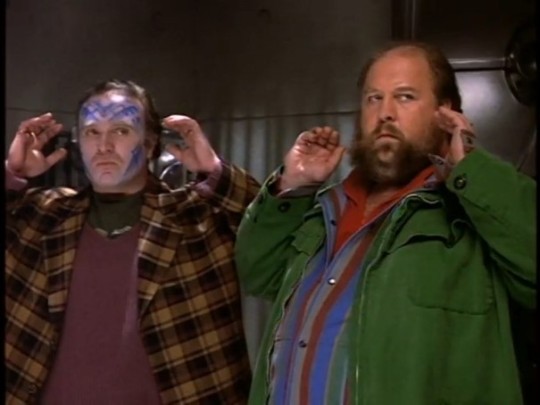

Jefferson Mappin as a tech scientist who loses his memory in an episode of TekWar in 1995.
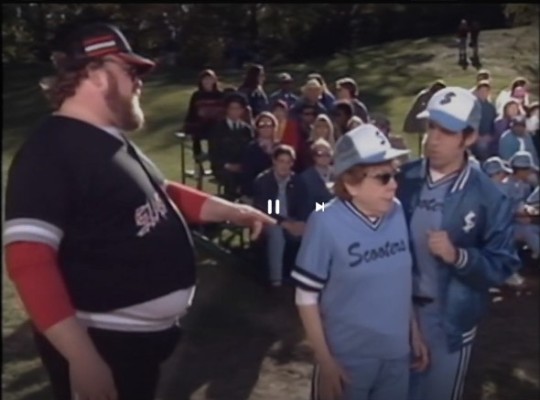
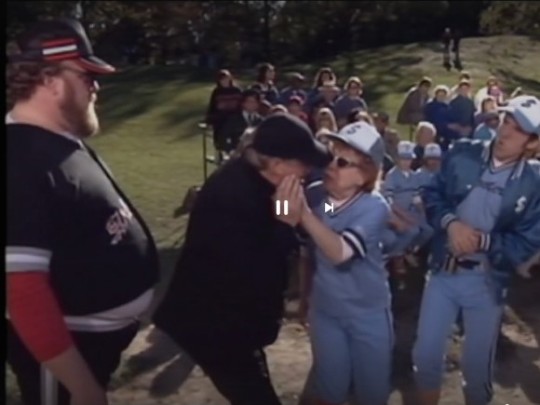
Jefferson Mappin as a Little League Coach in the TV Movie Shining Time Station: Second Chances in 1995.
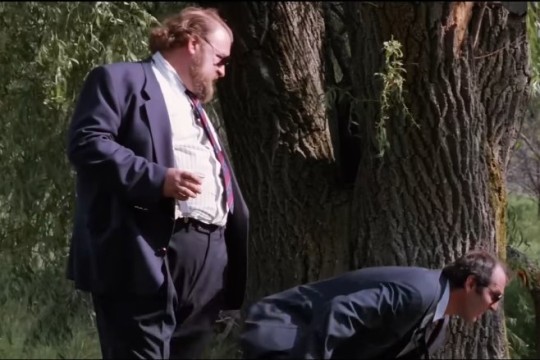
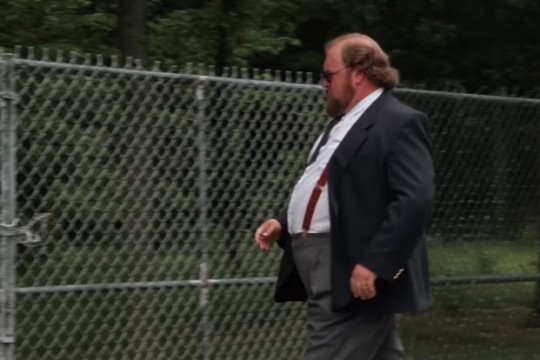
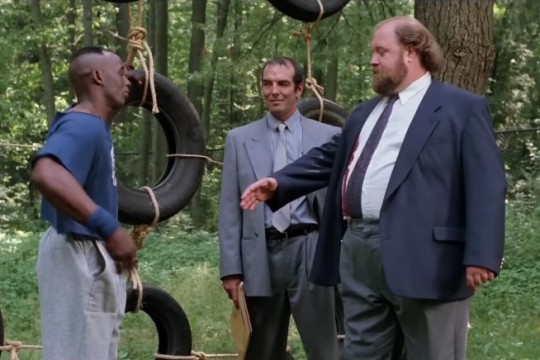

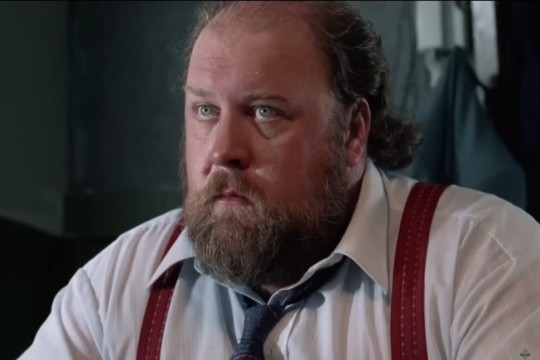
Jefferson Mappin plays a Federal Agent in the Sci-Fi Action film Expect No Mercy in 1995.
33 notes
·
View notes
Text
some highlights from this 2004 adam norris money marketing profile:
"There are few managing directors younger than Adam Norris of Pensions Direct, the pension arm of Hargreaves Lansdown. At 33, he has achieved a higher level in the industry than most do in their entire career."
"Norris quips that early retirement would be readily available to him yet it is a very unattractive option. 'I do not believe in going to the office for the sake of it. I enjoy every day of my working life. I am lucky enough that my work is also my hobby. The day I stop enjoying it is the day I will retire.'"
"He also takes his hobbies very seriously and, before entering financial services, spent a year in Europe pursuing a career as a tour cyclist. He trained in Belgium with the hope of becoming a serious competitor in the Tour de France. While not making it as a professional, he did come back to the UK with a new outlook and a wife."
"Yet Norris maintains he still only works regular hours and prefers not to work later than 5.30pm if he can help it. He refuses to take work home. 'It is a matter of working smarter rather than harder, which is something we need a lot more of in the financial services world.'"
"Comments like these demonstrate Norris's forthright pragmatism, that seems to stem from his structured, mathematical training as an engineer and his hard-work ethic, which he says is a result of growing up with dyslexia and needing to work things through.
'I have become very good at learning and observing the world through truly different eyes to everyone else. If you cannot spell, who cares? Working out solutions to difficult problems and understanding the world we live in is vastly more important.'
This is a tenet he aims to pass on to his children through real-life experience. He has bought a small farm in the West Country where he has sheep and other animals. 'Real-life experience is most important for a good grounding in anything. I am always conscious that financial services is a world unto its own and, the more of the outside world you see, the saner and more balanced you are.'"
"Education: BEng, University of Leicester
Career: 1993-95 financial adviser, Acuma; 1995-98 IFA for small brokerages in Bath and Bristol; 1998-present managing director, Pensions Direct, the pension arm of Hargreaves Lansdown
Career ambition: To be the biggest shareholder in Europe's biggest IFA
Life ambition: To enjoy every day
Hero: Doesn't have one
Likes: Jam sandwiches
Dislikes: Marmite
Drives: Porsche 911 convertible"
#the bits i left out are more focused on him being goated at his job i guess#he's very interesting in his own right#and his career is (from what i can tell) out of the ordinary lol#more coming soon maybe. or well like#this is the personable bit. that has some parenting insights? the rest are interesting in terms of career tea tbh#which ill probs post some highlights from the other articles all in one post for myself lol#ln#(well. kind of)#lore#adam norris
26 notes
·
View notes
Text


˚₊‧꒰ა ♡ ໒꒱ ‧₊˚ ALLUME is a six member generational girl group under Flowerbank Entertainment. They debuted in 2000 with a five-member line up. Their debut single GET UP became an instant hit, topping the South Korean charts and even breaking into the Japanese charts. Their successful debut would prove to be the blueprint for how the group would perform for years to come.
The group operates on a generation system, being one of the few K-pop groups to do the system properly and consistently. Every five years, the group will undergo a graduation of all the members and bring in new members, ushering in a new generation of Allume. The group is currently in its fifth generation.
Often compared to AKB for their extravagant stage outfits and graduation ceremonies, the group is performance-focused and has been home to some of the greatest performers in Flowerbank Entertainment. Most girls who graduate from Allume go on to become soloists or actresses, staying under Flowerbank. The group's generations all come together every five years to perform together, a tradition to usher in the new generation.
They are not without their scandals of course. They've been hit with plagiarism scandals in their early days, getting sued by SM Entertainment at one point for allegedly plagiarizing S.E.S's "Dreams Come True" in 2001. Though this dispute was settled outside of court, it still followed the first generation for the remainder of their career. Various members have found themselves in dating scandals and bullying scandals which is to be expected with a group of this size.

゙ . ✩ . ' ۫ ، CHAPTER ONE. ── THE BASICS
MANAGED BY ... FLOWERBANK ENTERTAINMENT
DEBUT DATE ... FEBRUARY 12TH 2000
CURRENT LINEUP ... RUBI, DAEUN, YEBIN, YUI, JAEHWA, FAME.
DEBUT SINGLE ... GET UP!
CONCEPT ... DIFFERENT GENERATIONS, PERFORMANCE, PINK, ROTATIONAL.
GREETING ... ALL OF YOU! WE'RE ALLUME!
FANDOM NAME ... ADORES
FANDOM COLOR ... PINK & BLACK

゙ . ✩ . ' ۫ ، CHAPTER TWO. ── THE GENERATIONS
2000 - 2005 ── FIRST GENERATION.

KIMURA TOMOMI / TOMIE KIM ... 1981
BAE HYEJIN ... 1980 ( LEADER )
KIM YUJIN ... 1984
MORI RIKU ... 1986
LEE SOOJIN ... 1980
2005 - 2010 ── SECOND GENERATION.

MYRAH YAMAZAKI ... 1987 ( LEADER )
ZHAO JIA ... 1987
JUNG SUNGHEE ... 1989
KIM SORA ... 1991
KIM SOOAH ... 1990
LEE BADA ... 1992
2010 - 2015 ── THIRD GENERATION.

JUNG YURA ... 1995 ( LEADER )
MARISOL DIAZ ... 1993
HAN HYUNA ... 1994
LEE HYUNJOO // JINAH ... 1994
PARK EUNJI ... 1995
ANALISE YAN ... 1997
2015 - 2020 ── FOURTH GENERATION.

KWON MINYOUNG ... 1997
LUCIA MICELI // LULU ... 1996
NAM MINJI ... 1995 ( LEADER )
SARA LIM ... 1998
NATTICHA PIPITDAECHA // POPPY ... 2000
2020 - 2025 ── FIFTH GENERATION.
#★ & ☆ ALLUME --— PROFILE .#ficnetfairy#fictional idol community#idol oc#kpop oc#idol au#oc kpop group#fictional idol group#kpop fanfic#fake kpop oc#kpop au#kpop addition#idolverse#oc girl group#bts addition#fake kpop girl group#fake kpop idol#stray kids addition
107 notes
·
View notes
Text
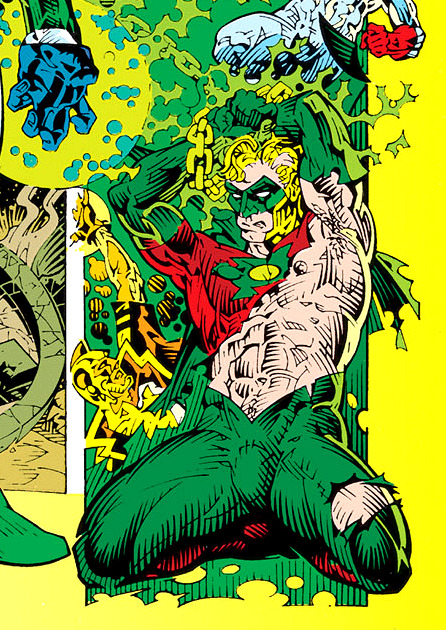
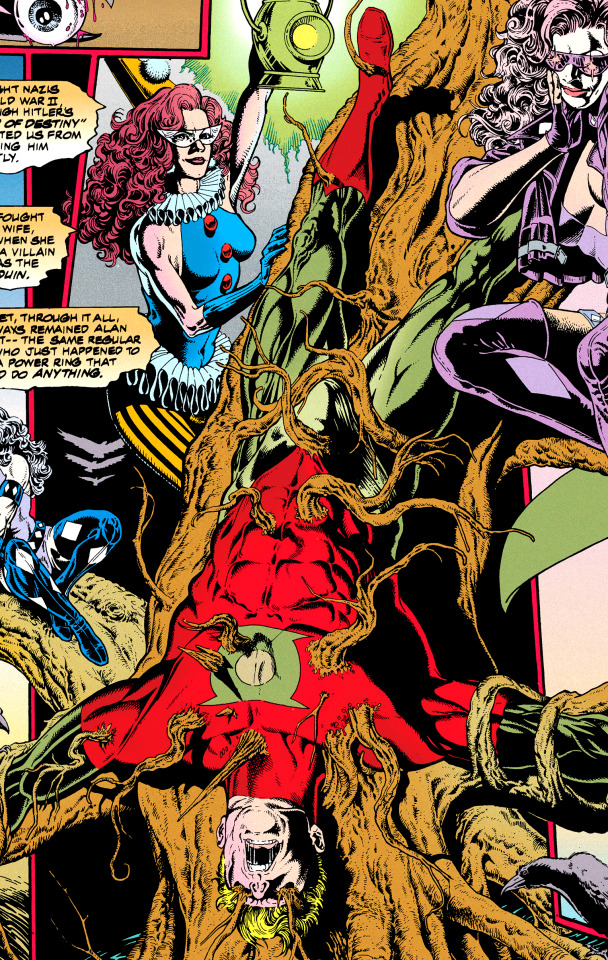
Green Lantern (1990) #55 || Underworld Unleashed: Abyss - Hell's Sentinel (1995) #1
I've often written about Alan Scott's Golden Age gaycoding, how he reads as gay from his earliest appearances, how his 1940s appearances are a treasure trove of subtext -- but there's no denying Alan's Sentinel era plays an equally pivotal role in the portrayal of his (once implied, now confirmed) sexuality over the course of his many years of publication.
The 1990s were a decade of change for Alan Scott. With his storyline in Green Lantern Corps Quarterly (1993), he'd regained his youth but consequently found himself rejected by his friends in the JSA, by his wife (it's here that Molly would start questioning the reality of their marriage), and brimming with anger. He'd soon take up the moniker of Sentinel to differentiate himself from the last Green Lantern still standing and he'd end up haunted by the deaths of his friends during Zero Hour: Crisis in Time (1994), soon fighting accusations of not being a 'real man' for having outlived them (as per Showcase 1995 #1).
Anger was the main driving force behind Sentinel but Alan Scott had always been an angry man, the most remarkable aspect of this era was a sudden sense of boldness -- an almost transgressive one, at that -- that Alan had never carried himself with before. In many ways, being young again had brought back his confidence (many might recall the "young man's body with a young man's needs" line from the aforementioned GLCQ arc) but it had also brought back the homoeroticism of those very early stories with a much sharper, much more tangible edge in what was in many ways a more permissive landscape. Alan's interactions with the personification of Chaos (shown as male but dressed in drag) in The Book of Fate (1997) #2 are a good example of the way Alan had carried himself throughout the '90s.
However, and more to the point of this little segue, the gaycoding of the Sentinel era is fundamentally legitimized by one simple fact: it wasn't just gay audiences who were catching on to what was going on with Alan Scott (and had been for a long time), it was gay creators as well.
The above images are undoubtedly homoerotic, the fact that they were drawn by gay artists Craig Hamilton and Phil Jimenez respectively only underlines this undeniable aspect. Both in and out of universe, it's a striking portrayal of gay sexuality that is simply not seen in today's sanitized gay stories -- no matter how explicit of a confirmation we get nowadays, it's nothing close to what had gone unsaid a few decades ago.
#alan scott#green lantern#jsa#justice society of america#justice society#dc#dc comics#dcedit#comicedit#comicsedit#u can reblog#im just saying some comics will show you alan actively hard. and its not the ones theyre publishing rn
27 notes
·
View notes
Text
SORTING DISNEY LADIES (1995-1998)
Part 1 - Disney Ladies 1937-1985
Part 2 - Disney Ladies 1988-1993
I’m going in chronological order, and doing both A Squad and B Squad, because I’m interested in tracking how the ideal “disney girl” has changed in the past 85 years (right now I’m only looking at the human-shaped heroines of Disney animated theatrical releases) A more detailed break-down of the system I’m using is right here, but the basics are these:
PRIMARY (ie MOTIVE)
BADGER ~ Loyal to the group.
SNAKE ~ Loyal to yourself and your Important People.
LION ~ Subconscious Idealist. Ideals are linked to feelings and instincts.
BIRD ~ Conscious Idealist. Ideals are linked to built systems and external facts.
SECONDARY (ie METHOD)
BADGER ~ Connect with the group. Make allies, work steadily and well. Be whatever the situation calls for. If you find a locked door, knock.
SNAKE ~ Connect with the environment. Notice things. Tell people what they want to hear. If you find a locked door, get in through the window.
BIRD ~ Collect skills, tools, knowledge, personas, useful friends. If you find a locked door, track down the key or learn to pick the lock.
LION ~ Be honest, be direct, speak your truth. Either the obstacle is going down or you are. If you find a locked door, kick it in.
POCAHONTAS (1995)
(& John Smith)
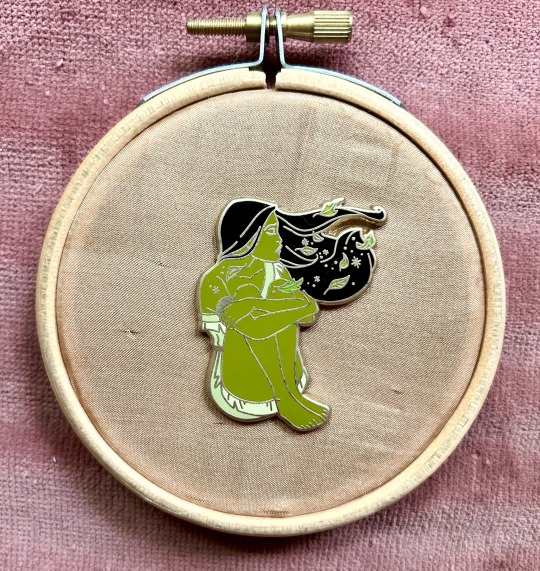
Pocahontas is an incredibly loud Lion Primary. Marrying Kocoum is the good choice, the responsible choice, the right choice - she knows this - but she just can’t do it. It feels wrong. She “goes wherever the wind takes her,” accompanied by the swirling leaves that are a kind of physical manifestation of her primary, since they match up so perfectly with the compass. (Classic Lion primary metaphor - see also Jack Sparrow.) When Pocahontas doesn’t know what to do she dreams of the confusing “spinning arrow,” but when she does... that arrow points straight in one direction and she just goes. She “listens with her heart” to the degree that it gives her superpowers.
It’s tempting to say she’s a Lion secondary too. She enjoys whitewater rafting and BASE jumping, which I guess are activities stereotypically associated with Lion secondaries. Also, the climax of the movie does involve her physically flinging herself across John Smith’s body. BUT her big song (“Colors of the Wind”) is just so, so, SO Bird secondary. John Smith isn’t getting it, and so Pocahontas’ response is - let me explain my worldview, show you, you clearly don’t have all the information. She’s a problem-solving Bird. Pocahontas’ first instinct when the English arrive is to investigate from the shadows, with two animal sidekicks that represent Curiosity and Caution. (Which is perfect, because is that not what a Bird secondary is? Observe, assess, plan.) Pocahontas is also convinced that there must be some perfect way of explaining her situation to the rest of her tribe that will make them get it. In her eyes, the problem is again that they don’t have all the information. This is almost a Bird secondary compulsion.
As for John Smith, well. His arc is about shifting his definition of “Person” to include everyone he categorized as “savages” early in the film. That’s very Badger primary character development, and John Smith is very Badger primary. He loves being part of a group, he loves his men, and the fact that he doesn’t really belong anywhere bothers him. The implication is that he keeps going to all these “New Worlds” trying to find one where he fits. It’s a cool bit of costume design that he’s the only one in Spanish armor - like maybe he did a similar trip with the Spanish conquistadors a few years ago. And it’s gutsy that his ‘I want’ song (“Mine”) is literally a duet with the villain. Like, sure John Smith and Governor Ratcliffe don’t like each other, but they start off with pretty similar politics.
I like that at the end John isn’t accepted into the Powhatan tribe or something. He finds personal peace by redefining his own community, and gaining a broader perspective on the world. HE is absolutely a Lion secondary though: really straightforward, cannot lie, and always solves problems by throwing himself physically at them. Pocahontas only does that the once, after her Bird secondary strategy - trying to reason people around to her point of view - didn’t work.
ESMERALDA (1996)
(& Quasimodo, Claude Frollo, Phoebus)

At first Esmeralda seems like she might also be a Lion primary. She’s the revolutionary, she stands up on platforms and yells things like “Justice!” Even through all the adaptational changes, the Victor Hugo soul of the story is still very much there, and he loves a Lion primary. But��� that’s not really where Esmeralda is coming from. She cut Quasimodo’s bonds very specifically to try and change the vibe of the room - “Letting the crowd torture that poor boy? I thought if one person could stand up to him…” And that’s a Badger primary motive. Esmeralda has deep roots in her outsider community, and being separate from them (trapped in the cathedral) is very, very bad for her.
But then she brings Notre Dame itself into her community. Esmeralda goes up to the statue of Mary, the cathedral's patron, and says, “Still I see your face and wonder / if you were once an outcast too.” Once she does that, the ‘outcast’ bellringer of Notre Dame and even the building itself start fighting for her. It’s important that Esmeralda’s ‘I want’ song has nothing up to do with her at all. “God Help the Outcasts” is about helping her community - the outcasts. We get lines like “I ask for nothing, I can get by / for I know so many less lucky than I” which are all about Badger primary need-basing. Esmeralda consistently goes to whoever needs her help the most, doesn’t matter if she knows them or not. And her way of helping Quasi is to give him a map of the city that brings him straight to her Community.
It’s nice to pair this very understanding, inclusive Badger primary with basically a Jack Sparrow secondary. Esmeralda likes disguises. She likes improvising weapons. She improvises her escapes, and comes up with stuff as she goes along. She also has a lot of faces that are all equally her. She is the sexy pole dancer. She is also the grounded, spiritual earth mother, and when her primary requires it, she’s the revolutionary too.
If you put the weird tonal mismatch that is the gargoyles to one side, this film has a really elegant little structure. There are three men who are in love with Esmeralda: Quasimodo, Claude Frollo and Phoebus. And it’s subtly done, but Quasi and Frollo both dehumanize her - Frollo by only seeing her sexy side and deciding she’s a demon temptress, and Quasi by only seeing her more motherly side and deciding she’s an angel. I always thought it was interesting that “Heaven’s Light” and “Hellfire” - Quasi and Frollo’s songs about Esmeralda - are back to back, with similar titles, even the same track on the soundtrack. They’re almost a duet, and I think it’s a way of showing that there are two ways to make someone inhuman. (In a movie that is SO interested in the idea of what makes someone inhuman.) And then Phoebus just sees Esmeralda as… this cool chick, with a great sense of humor and some sweet moves, who he’d like to get to know better. Of course she goes with him.
Frollo, Phoebus and Quasi are ALL Lion secondaries (no wonder they butt heads.) It’s harder to tell with Quasi, because his secondary is so ridiculously Burnt, and only wakes up once his Snake primary finds something to latch onto that isn’t Frollo… which takes him most of the movie. Phoebus has a very straightforward Paragon Lion primary that seems to match up with Esmeralda’s Badger, and Frollo, oh man. Frollo has the most twisted Bird primary imaginable. He has a belief system that is impossible to live up to, so - instead of maybe questioning that - he blames Esmeralda? Or he blames God? for making Esmeralda too tempting for him to resist? and so therefore it’s not his fault? He’s a Bird Primary who consistently fails at following his system, and deep down he knows it. That’s why he’s so scared of the actual Notre Dame cathedral, why it keeps hurting him, and why it ultimately kills him. He cannot look those statues in the face, he cannot look at the system he tells himself he follows better than anyone else.
(Inspector Javert of Les Mis is also a Bird Lion villain. Big Victor Hugo trope.)
MEGARA “MEG” (1997)
(& Hades)

Meg is the example I would use to illustrate a Burnt Snake primary. She sold her soul (gave up everything) for her boyfriend, he left her, and now she doesn’t think it’s safe to love like that again. “Look I learned my lesson, okay? I’ve sworn off man handling.” Meg won’t let herself trust anyone: “He comes in with this big handsome farm boy act, but I can see though that in a Peloponnesian minute.” It’s because she doesn’t trust herself: “If there’s a prize for rotten judgement / I guess I’ve already won that.”
Her only connection in the world is Hades, this weird and kind of compelling combination of bitchy best friend and shady producer who’s trapped her in a bad five-record deal. They are both similar flavors of Snake secondary, which is how they they can be antagonistic… but still kinda get each other, and work well together. They both enjoy sitting in a kind of blunt Neutral, but get things done by being charmers - creatively telling the truth, and switching approaches quickly in order to to figure out what resonates best with the person they're talking to.
We see Meg use Hercules’ fan girls as a smokescreen to sneak into his villa, and then talk him into playing hooky and having a night on the town. After which, she falls into his arms with her line about “weak ankles” as a way to get him to get him talking about potential weaknesses. But of course, she catches feelings and her big song “I Won’t Say I’m In Love,” is a nice little portrait of a Snake primary unBurning. Meg goes from not trusting herself at all, to deciding that… maybe it could be different this time.
And this is where Hades misreads Meg, which is ultimately his downfall. He assumes that Meg is a Lion primary like he is. Because Hades is (a bit of a narcissist) and a huge Glory Hound Lion. He hates that he got the shitty assignment, hates that things are “a little dark, a little gloomy, and as always, hey - full of dead people." He wants to be the top dog, he wants to be Zeus. So he offers Meg freedom. That's what a Lion primary like him would want more than anything, were he in her position. But Meg’s not a Lion. She’s a Snake. So we get exchanges like this:
HADES. Hear that? It’s the sound of your freedom, fluttering away.
MEG. I don’t care. I won’t do anything to hurt him.
And Hades just does not see that coming.
FA MULAN (1998)
(& Fa Zhou, Mushu, Li Shang, Shan Yu)

So my question is... why does Mulan run away and join the army? Get the obvious answer out of the way - it's not “to uphold the family honor."
FA ZHOU. It is an honor to protect my country and my family.
MULAN. So you’ll die for honor?
Fa Zhou is definitely a Badger primary, and Mulan… isn’t. She doesn’t get it. He’s not speaking her language. But she clearly loves her dad, and the next explanation we get is that she did it all to protect him. However, at her lowest and most vulnerable she says - “Maybe I didn’t go for my father. Maybe I went to prove that I could do things right.” That’s an interesting shift. Now the issue isn’t with why she acts, it’s with how she acts. Which means Mulan’s internal conflict isn't coming from her primary, it's coming from her secondary.
This is where we start getting into gender and gender performance. There is a lot of Badger secondary in this movie, and it’s all framed as female (Mulan's mom and grandmother are both Badger secondaries, for example.) There’s also a lot of Lion secondary, which is framed as male. (Fa Zhou, Li Shang, and Shan Yu are all Lions.) And Mulan… tries both options, and fails both times. She gets into a huge amount of trouble trying to be the quiet, caretaking bride at the matchmaker’s, and just as much trouble trying to be the brash, fight-starting Ping at the camp.
Then we have Mushu, who is Mulan's Lion secondary coach… despite not being a Lion secondary himself. He wants to be - disgraced failure Mushu is introduced trying to breathe fire and shake awake the bigger, tougher Great Stone Dragon. He’s trying to seem like an intense Lion when he is happiest and most effective doing a more Badger secondary thing. He comforts Mulan, makes her breakfast, carefully forges letters, wins her allies and generally gets… maternal (“my little baby is all grown up and saving China.”) This is a smart movie, and in a very light, comedic way… it’s saying that Mulan is not the only one self-sabotaging because of gender presentation roles.
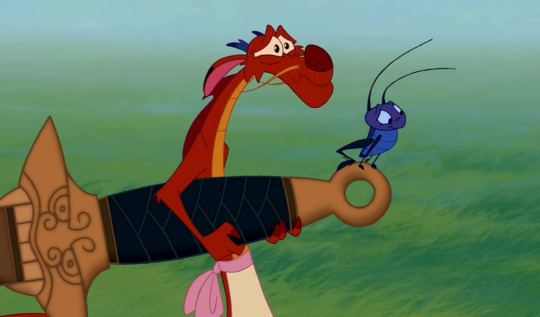
So Mulan tries to be a Badger, which doesn’t work. She tries to be a Lion, which doesn’t work. And eventually, of course, realizes that she was a clever, inventive Bird secondary all along. We are introduced to her while she's making little gadgets to do her chores, and when she taps into that she becomes powerful. She is able to figure out a way to use the handicap weights to climb the post and reach the arrow, and defeat Shan Yu’s army by starting an avalanche. She even finds time to plan during the heavily improvised final battle in the palace. Mulan coordinates a two-pronged attack, luring Shan Yu up onto the roof, where she knows Mushu is already in place with a rocket.
As for why she does things… Mulan has an intrinsic inner truth, and just wants to project that truth out into the world. She’s a Lion primary who wants to “be myself” be “true to [her] heart,” and not hide. “When will my reflection show who I am inside?” Lion primaries will get hit especially hard with that kind of identity angst.
And to round out the sorting for this film (which really holds up) - Mushu is probably a Lion primary like Mulan, which is why he gets where she’s coming from. He starts off as a bit of an immature “stage mom” Glory Hound Lion, but gets better. Shang is definitely a Loyalist, probably a young Badger primary. (I think Mulan just likes Badger Lions, her dad is one too.) Shang is very group-orientated, wants to be “the leader of China’s finest troops - no, the greatest troops of all time!” He's also, to be honest, kind of Establishment. Shang has a much harder time getting his head around Girl!Ping then Mulan’s more Snakey buddies, and ultimately needs an authority figure to tell him to cut it out. And Shan Yu, the film’s comment on toxic masculinity, seems like an Exploded Lion primary. He gives his motivation in the first scene- “[the Emperor] invited me. By building his wall he challenged my strength.” Which means that - with the single exception of Hades... all the guys in this wave have been masculine-coded Lion secondaries, and the heroines aren't girly Badgers, but the cool "third option" - Birds or Snakes.
Tl;dr
Pocahontas ~ Lion / Bird (occasional Lion model)
John Smith ~ Badger / Lion
Esmeralda ~ Badger / Snake
Quasimodo ~ Snake / Burnt Lion
Phoebus ~ Paragon Lion / Lion
Claude Frollo ~ Burnt Bird / Lion
Megara ~ Burnt Snake / Snake
Hades ~ Immature Lion / Snake
Fa Mulan ~ Lion / Bird (unhealthy “girl coded” Badger performance) (unhealthy “boy coded” Lion performance)
Fa Zhou ~ Badger / Lion
Mushu ~ Immature Lion that matures / Badger (unhealthy Lion performance)
Li Shang ~ Badger / Lion
Shan Yu ~ Exploded Lion / Lion
(art credit to Cursed Concepts for the beautiful pins I have used to illustrate this post.)
#sortinghatchats#shc#disney#wisteria sorts#disney princess analysis#disney princesses#pocahontas#pocahontas meta#john smith#hunchback of notre dame#esmeralda#phoebus#quasimodo#claude frollo#judge claude frollo#esmeralda meta#disneys hercules#megara#hades disney#mulan#mulan meta#mushu#fa mulan#fa zhou#li shang#shan yu
77 notes
·
View notes
Text
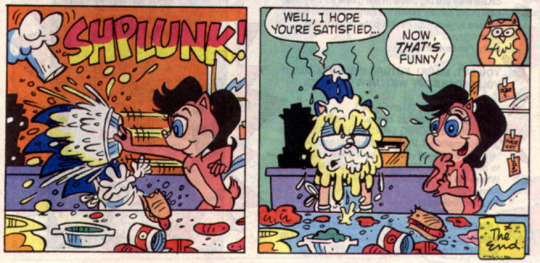

Hoot hoot motherucker
#1993-1995: the early years#Sonic the Hedgehog#Sonic the hedgehog comic#Sonic Archie#Sonic the hedgehog 1#Sonic#Sally Acorn
44 notes
·
View notes
Text
HC Scarlet/Violet timeline
This is based on information from the game (most of it being Raifort’s history course and the notes in the Zero Area Research Stations) as well as a general assessment of what makes most sense based on apparent ages etc. The only thing that doesn’t make sense internally in the game is Raifort’s statement that the Tera Orb was invented ten years before game time, when the notes in the Research Stations clearly state that Sada/Turo invented the orb before Arven was born. If both are right, then Arven is 9 years old or younger, which clearly isn’t right, so I’ve gone with the notes in the Research Stations and assumed the Tera Orb was invented over ten years before game time.
Timeline assumes start of game takes place in late 2022.
--
1,000,000 BCE - Formation of the Paldean crater
0 CE - Rule of the Paldean Empire
0-1000 CE - The Era of Exploration
1217 - Unification of Paldea, establishment of the Academy
1822 - Area Zero Expedition with Heath
1820s - Heath publishes the Violet Book
1882 - Discovery of terastallised Pokemon in the Great Crater
1962 - Clavell is born (making him 60 in game)
1975 - Sada/Turo is born (making her/him 47 in game)
1986 - Jacq is born (making him 36 in game)
1989 - Clavell (27) leaves Paldea for travel/work
1993 - Sada/Turo (18) enrols at the Academy (which I HC at that time was a higher education institution, it opened up to various ages later).
1995 - Sada/Turo (20) graduates, becomes a tutor/researcher at the Academy (his lab is Clavell’s current office).
2000 - Clavell (38) returns from travel/work overseas, takes up a teaching post at the Academy. Meets Sada/Turo (25).
2002 - Sada/Turo (27) “leads” a research team (incl Clavell, 40) into Area Zero. Leads in quotes because Clavell is supervising behind the scenes. Sada/Turo’s lab at the Academy is held for him in the interim.
2003 - Sada/Turo (28) discovers the crystals cause terastallisation.
2004 - Sada/Turo (29) invents the Tera Orb prototype; receives corporate funding. Disturbed by Sada/Turo’s talk of past/future Pokemon, Clavell (42) stays only to help perfect Tera Orb for mainstream distribution. Sada/Turo’s resulting profile leads the Academy to preserve his old lab.
2005 - Sada/Turo (30) sets up a lab at Cabo Poco Lighthouse; Clavell (43) moves to a different research facility (Paldea? Elsewhere? Unsure). Later that year, Sada/Turo returns to the Crater, moving research to the Zero Lab with a “smaller team”; conducts time machine research.
2007 - First Koraidon/Miraidon brought through time machine. Meanwhile Jacq (21) starts work as a junior researcher, meets Clavell (45).
2008 - Arven is born (making him 14 in game). Sada/Turo is 33. Turo/Sada leaves within the year.
2009 - Sada/Turo (34) creates AI assistant. Between Sada/Turo and the AI, they manage to raise Arven.
2011 - Second Koraidon/Miraidon brought through time machine.
2017 - Jacq (31) develops the Pokedex App for the Rotom Phone.
2019 - Arven (11) enrols at the Academy.
Early 2021 - Operation Star; Harrington resigns along with the rest of the staff. Clavell (59), Jacq (35), and other staff join the Academy. Clavell moves into Sada/Turo’s old lab.
Late 2022 - Second Koraidon/Miraidon kills Sada/Turo (47); First Koraidon/Miraidon flees; AI Sada/Turo asks Clavell (60) to be put in touch with MC.
Early 2023 - Events at the Zero Lab; destruction of the time machine.
#pokemon scarlet and violet#pokemon sv#pokemon sv spoilers#sada#turo#professor sada#professor turo#clavell#director clavell#arven#jacq#pkmn#x#thoughts welcome btw
181 notes
·
View notes
Text

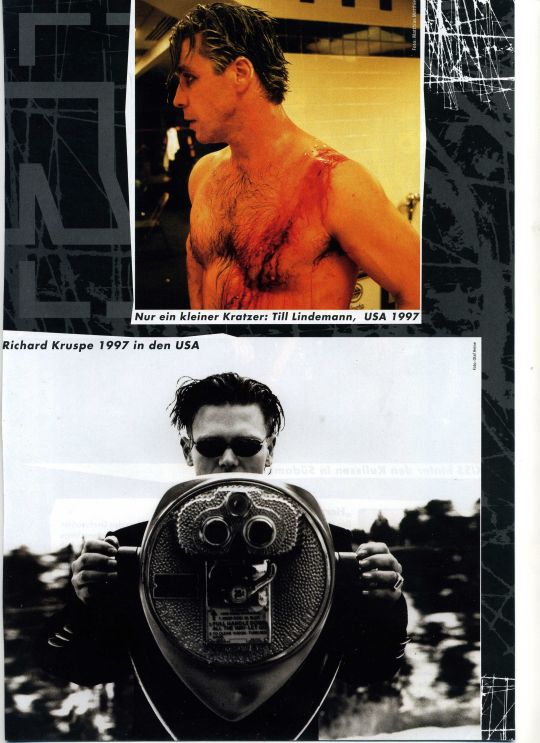
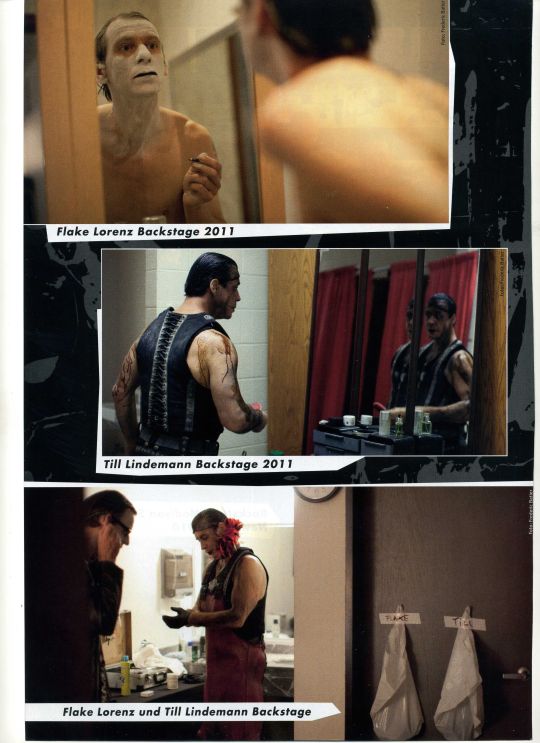

Sonic Seducer, December 2015
Thanks to ramjohn for the scans!
What's 32 cm high, weighs 3.5 kilos and contains 14 discs? Rammstein fans probably already know the answer: it's “XXI - The Vinyl Box Set”, a big box set that will enable the Berlin band to look back over their 20-year career in early December. Even if the band's website recently announced a meaningful "It goes on” [“Es geht weite”], the fact that all the sextet's works will soon be available in record form for your personal collection comes just at the right moment: "XXI - The Vinyl Box Set" contains all the studio albums on double vinyl, from "Herzeleid" to "Liebe Ist Für Alle Da", and adds two LPs with previously unreleased tracks and versions as well as "Raritäten". So it's interesting to review the career of Germany's most internationally popular band since Kraftwerk, from their early days as a band with a martial R roll, to their export successes filling arenas and stadiums around the world.
Of course, no one was expecting such resounding success when Rammstein was formed in Berlin at the end of 1993, from members of East German bands The Inchtabokatables and Feeling B, among others. The first album from 1995, “Herzeleid”, was a bombshell: some drew parallels with the sound and image of over-identification and pseudo-fascist totalitarianism of Slovenia's Laibach. Others suspected Rammstein were the counterpart to Die Krupps, the electro-metal band that was enjoying huge success at the time. The first sign of life from their Motor Music label was the promotional CD of the song “Du riechst so gut”, the mix of thick synthetic groove, brutal industrial metal and powerful male vocals was immediately on everyone's lips and in everyone's ears. “Herzeleid" barely cracked the top 100 album charts when it was released, but a growing audience began to take an interest in these Berliners when they opened for Project Pitchfork, among others. Even cult director David Lynch took notice and chose the songs "Rammstein" and "Heirate mich" for the soundtrack to his film "Lost Highway" — in the US too, Rammstein made an early name for themselves, soon to become a fixture on the international (industrial) metal circuit. "Herzeleid" laid an impressive cornerstone in this respect.
“Herzeleid” (1995)
The first album opens with a song that quickly became a crowd favourite: "Wollt ihr bas Bett in Flammen sehen" introduces massive guitar punches and a bubbling electronic base. What's more, Till Lindemann repeats the band's name so often that no-one can ignore who's playing. The album already shows the extent of the Berliners' palette: the opener and hits like “Du Riechst So Gut” and “Asche Zu Asche” are set against “Seemann”, a ballad that proves Rammstein can slow down the pace without losing any of their intensity. But “Herzeleid” is most legendary for its brutality — admittedly, there's nothing on the album, musically speaking, that Oomph! hasn't mastered, but the gigantic staging of itself and the overflowing pathos give Rammstein its own signature right from the start.
"I find the 'Herzeleid' cover so bad that I can't watch it anymore.” — Richard Kruspe (1999)
Rammstein made a big impression on metal, industrial and electro fans with just one record, as demonstrated by the single "Engel", which stormed the charts before the release of their second album "Sehnsucht". After “Herzeleid” frightened uninformed listeners with songs about scandalous subjects such as necrophilia, sexual violence and plane crashes, the “Engel” music video turned out to be a more or less explicit homage to “From Dusk Till Dawn”. But the controversy was over the cover of “Sehnsucht”, by Austrian extreme artist Gottfried Helnwein, who fitted the members' faces with surgical instruments — so the similarities with the artwork for Scorpions' 1982 album “Blackout”, also by Helnwein, were not coincidental. The second single, "Du Hast", also made it into the German top 10, and Rammstein took the top spot in the album chart with "Sehnsucht". Abroad, particularly in the United States, a similar success was beginning to be felt: "Sehnsucht" won a golden record there and continued to sell well, going platinum record at a later date. A year later, Rammstein were represented with their cover of Depeche Mode's "Stripped" on the tribute compilation "For The Masses" — alongside international acts such as The Smashing Pumpkins, The Cure and Deftones. The fact that the Berliners used scenes from Leni Riefenstahl films in the video not only earned them accusations of right-wing extremism, but could also be seen as a clever provocation. Rammstein denied any fascist tendencies, however, and soon after went on a "Family Values" tour across the United States with Korn, Limp Bizkit, Orgy and Ice Cube. By then they had become stars.
“Sehnsucht” (1997)
With “Engel” and “Du hast”, Rammstein had already scored hits before the release of their second album, and this one did not disappoint. So it's hardly surprising that the song “Tier” was so clearly inspired by Die Krupps' “The Dawning Of Doom” that Jürgen Engler received the copyright after the fact. In terms of content, the band also goes all the way: incest and the resulting parricide, sado-masochistic sexual practices and female genitalia craving cunnilingus are all hot topics — and with “Klavier”, we also find a legitimate successor to “Seemann”. Sales of "Sehnsucht" have long since topped the 2 million mark.
Rammstein in Mexico 1999
Needless to say, Rammstein have not given up in the face of this phenomenal success: ever since the band toured Central and South America with Kiss and Soulfy in 1999, the qualities of these men with showmanship skills have been known there too. With the first retrospective of their work "Live aus Berlin", the first phase of their creative process came to an end shortly before the turn of the millennium, and after a concert at the Fuji Rock Festival in faraway Japan, Rammstein tackled their third album. And, of course, the band didn't think to get rid of its provocative habit, even though singer Till and keyboardist Flake Lorenz had been arrested two years earlier in Massachusetts for simulating anal sex on stage and spraying themselves with artificial sperm on the song "Bück dich". Instead of being sexually explicit, the 'Mutter' album polarised attention with its cover illustration of an allegedly dead foetus. Nevertheless, Flake shakes his head about his arrest and the allegedly evil band Rammstein in an interview with Der Spiegel magazine: "What are they blaming us for? That we dare to use words like 'ficken' and 'Fotze'? That's what every hip-hopper does these days". Especially since “Mutter”, with the song “Links 2 3 4”, effectively distanced the band from the accusations of fascism that the worried media were constantly calling for. An important album for this reason too.
"Mutter" (2001)
Could this be the reason why Rammstein tribute band Die Bestien were originally called “Mama ist die Bestie”? In any case, the pleasure of listening to bestiality is once again guaranteed on "Mutter", as the opening track "Mein herz brennt" already indicates, with its thunderous orchestral guitar. The Swedish director Lukas Moodysson featured this piece prominently in his tragic drama film "Lilya 4-Ever". What's more, with the right-turn rejection of “Links 2 3 4”, the electronically infiltrated mass delirium of “Ich will”, the suggested cloning insult of the title track and “Rein raus”, which calls for abdominal activity, there's enough to cause a stir, if not outrage. Not at all revolting: “Mutter” also topped the charts — like every Rammstein album since “Sehnsucht”.
In the meantime, Rammstein had reached the centre of metal society, as evidenced by the award for "Best International Live Act" at the Kerrang! Awards 2002. While the band were working on their fourth album, the three-hour DVD “Lichtspielhaus” kept the audience on their toes: it contained all the video clips shot so far, plus a few making-of and various concert highlights, recorded at shows in Sydney and Rock am Ring among others. A deep breath before the next album, “Reise Reise”, whose cover depicts a flight recorder. If you rewind the CD before the first track, you hear the last radio messages from a Japanese airliner that crashed, killing over 500 people. Other provocations were not long in coming: the theme of the single "Mein teil" was the criminal case of Armin Meiwes, who had gained dubious notoriety as the cannibal of Rothenburg, and for some uninformed listeners, lines like "Weiche teile und auch harte / Stehen auf der Speisekarte" were already too much. Keyboardist Flake couldn't understand the excitement on this track either: "Doing a song about something that's really happened, I think that's the most normal thing in the world! Nobody complains to the presenter of the 'Tagesschau' about the alarming news he reads either!" For Rammstein, on the other hand, the attention paid to the unsavoury anthropophagy affair was anything but normal, given that at the time the war in Iraq had just been approved without the national media being overly concerned. A context in which the hateful praise of “Amerika” took on a whole new meaning.
"Reise, Reise" (2004)
This record definitely propelled Rammstein to the top of the list of most successful German bands abroad — it was ranked in the top 10 in nearly 20 countries, and number one in five of them. The “Bundesprüfstelle für jugendgefährdende Medien” (Federal Office for the Supervision of Media Harmful to Young Persons) could do nothing better with "Mein Teil" than ban the video clip, which is not very tactful in night-time rotation — a half-hearted sanction which Rammstein accepted with a shrug of the shoulders. Surprisingly, the band not only responded with musical crudeness, but also with dark, romantic, sometimes bluesy songs like “Los” and “Ohne dich”, and also with some ferocious and bizarre visual humour: in the video for “Keine lust”, the members appear extremely overweight and take the song about lack of energy and saturation to the extreme. But the truth is, Rammstein are far from fed up.
As benefits a band that subsequently sells out four concerts in a row at the Parkbühne in Berlin's Wuhlheide. And this time, it didn't take Rammstein long to recharge : so many songs remained from the “Reise, Reise” recording session that the sextet quickly returned to the studio to finish “Reise Reise Vol. 2”. But as the band doesn't like the idea of a musical residue, the new opus is finally called “Rosenrot” and not only continues the sound of its predecessor, but also takes new directions : The relatively tender experimental ballad "Stirb nicht vor mir" ("Don't Die Before I Do") features Texas singer Sharleen Spiteri in a duet with Till Lindemann, and "Feuer und Wasser" refers to Friedrich Schiller's poem "Der Taucher". Drummer Christoph Schneider sums it up : "We knew we'd recorded too many quiet songs for “Reise Reise”. That's why we were aware, when writing "Rosenrot", that we needed to compose some slightly harder material to round it all off". "Rosenrot" was not, however, completed by a tour, and performances in the United States, Mexico and Asia fell through due to the long-term illness of keyboardist Flake.
"We had no desire at all to produce this theoretical music on the computer. In contrast to "Mutter", this album is very hand-played." — Flake Lorenz
"Rosenrot" (2005)
The direct successor to “Reise Reise” is certainly not the most surprising album in Rammstein's discography — the punchy but familiar introductory single “Benzin” proves that right from the start. "Mann gegen mann" also rocks straight ahead and is once again only genuine with a video clip that was belatedly banished to the night hours, for which "Spun" director Jonas Akerlund has staged the band naked and had equally undressed men jostling each other. But on “Rosenrot”, Rammstein can also do things differently, orchestrating the Spanish song “Te Quiero Puta” with mariachi brass and ending the album with the modest title “Ein lied” — dedicated to all Rammstein fans. It's likely that some of them felt concerned.
"A situation that was completely new to us until then : writing songs from the nights in a very short time. There were many doubts within the band as to whether we could produce good quality songs in such a short time." — Oliver Riedel about "Rosenrot"
The breaks between albums became longer : apart from the live DVD "Völkerball", which was released in 2006, Rammstein disappeared from the scene for a while after "Rosenrot". But as usual, the band came back with a bang in 2009. But this was without taking into account the suspicions of the Bundesprüfstelle für jugendgefährdende Medien (Federal Office for the Control of Media Harmful to Young Person), which quickly placed the fifth album, “Liebe Ist Für Alle Da”, on the blacklist. What had happened ? Well, the song “Ich tu dir weh” appealed to sadomasochistic fantasies, which is hardly surprising in the Rammstein context, but was enough to warrant a blacklisting. The band expressed their dismay at the censorship, and much of the press sided with the band and against the authorities. "Spiegel" even imagined a fictitious and absurd round table discussion on the subject between the Minister for the Family, the band members and popular music star Florian Silbereisen. But you'd have thought the problem lay elsewhere, because the single “Pussy”, which pokes fun at German sex tourists abroad, lent itself much better to controversy. In the video, shot once again by Jonas Akerlund, the members of the band appeared without hesitation as hardcore pornographic actors — the fact that they were dubbed in the end did nothing to detract from the scandalous nature of the clip. According to guitarist Richard Kruspe, the initial impetus for this sultry little film came from the director, who sent an e-mail to the band with the words "Let's make a revolution! Let's shoot a porn!" And that's just the way it is : policing morals has never had any effect on the big boys of Rammstein.
"Liebe Ist Für Alle Da" (2009)
"Das Warten hat ein Ende / Leigt euer Ohr einer Legende" — the opening words of Rammstein's sixth album, which has once again lost none of its metallic power, textual provocation or musical versatility. As well as the catchy, almost cheeky "Pussy" and the hyperactive mosher "Ich Tu Dir Weh", the band pay tribute to Edit Piaf's "Non, Je ne regrette rien" on "Frühling in Paris" and draw heavily on the "Moritat von Mackie Messer" from Bertolt Brecht's "Dreigroschenoper" for "Haifisch". Admittedly, due to the aforementioned blacklisting, the song could only be sold to major customers for a short time, but a watered-down version of the offending track followed. Needless to say, by this time “Liebe Ist Für Alle Da” had already climbed the charts and Rammstein were still the most popular German band — both at home and abroad.
Rammstein 2014 in der Volksbühne
A lot has happened since the release of "Liebe Ist Für Alle Da": Rammstein were invited to the Wacken Open Air for the first time in 2013 — and didn't miss out on performing the song "Sonne" with Heino, who had covered it on his "Mit freundlichen Grüßen" covers album. Richard Kruspe lives again in Berlin and in 2014 presented his second Emigrate album "Silent So Long" with a lot of noise and the participation of Marilyn Manson and Jonathan Davis of Korn. Till Lindemann made common cause with Swedish metalhead Peter Tägtgren under the name Lindemann on the "Skills in Pills" album. And the announcement at the beginning of the article, "It goes on !", gives us hope that album number seven won't be too long in coming. In the meantime, let's listen to Rammstein's discography in detail once again — with "XXI - The Vinyl Box Set", of course, a luxurious package of power that Santa Claus will have trouble transporting.
"If we had put more emphasis on the live structure, then some things could have been a bit better, harder, more beautiful! And yet I'm simply happy that we've succeeded in making this record!" - Richard Kruspe about "Liebe Ist Für Alle Da"
#rammstein#till lindemann#paul landers#flake#oliver riedel#christoph schneider#richard kruspe#2015#*scans#translation#*#translated by endlich-allein
58 notes
·
View notes
Text
Considering the psychic damage my previous post on the protags' ages are, I've decided to compile ALL persona users' birthdays and list them according to date from earliest or oldest to latest or youngest. Enjoy!
Teddie (P4) - unknown, shadow so could be as old as time, maybe as teddy bears existed in humanity's collective unconscious memory, could be a month before he met the team, could be a week, could be last Thursday idk
Zenkichi Hasegawa (P5S) - unknown, in his 40s, probably late 1960s to mid 1970s
Baofu (P2:EP) - June 13, 1967
Tatsuya Sudou (P2:EP) - 1971
Katsuya Suou (P2:EP) - December 30, 1973
Ulala Serizawa (P2:EP) - November 30, 1974
Maya Amano (P2:IS) - July 4, 1976
Yukino Mayuzumi (P1) - April 9, 1979
Maki Sonomura (P1) - June 4, 1979
Masao Inaba (P1) - July 11, 1979
Reiji Kido (P1) - August 18, 1979
Eriko Kirishima (P1) - September 21, 1979
Kei Nanjo (P1) - October 2, 1979
Naoya Toudou (P1) - December 24, 1979
Hidehiko Uesagi (P1) - January 1, 1980
Yuka Ayase (P1) - March 3, 1980
Tatsuya Suou (P2:IS) - July 27, 1981 (EP), August 21, 1981 (IS)
Jun Kurosu (P2:IS) - February 14, 1982
Lisa Silverman (P2:IS) - May 4, 1982
Eikichi Mishina (P2:IS) - November 15, 1982
Tohru Adachi (P4) - February 1, 1984
Takuto Maruki (P5R) - unknown, possibly in his late 20s to mid 30s, probably mid-1980s to mid-1990s
Strega: Chidori Yoshino, Jin Shirato, Takaya Sakaki (P3) - unknown, late 80s - early 90s
Mitsuru Kirijo (P3) - May 8, 1991
Shinjiro Aragaki (P3) - August 11, 1991
Akihiko Sanada (P3) - September 22, 1991
Minato Arisato/Makoto Yuki (P3); Minako Arisato/Hamuko Arisato/Kotone Shiomi (P3P) - 1992/1993
Yukari Takeba (P3) - October 19, 1992
Fuuka Yamagishi (P3) - December 22, 1992
Junpei Iori (P3) - January 16, 1993
Koromaru (P3) - unknown, likely mid 1990s to early 2000s
Souji Seta/Yu Narukami (P4) - 1994/1995
Sho Minazuki (P4A) - unknown, possibly the same as P4 Protagonist, 1994/1995
Yosuke Hanamura (P4) - June 22, 1994
Chie Satonaka (P4) - July 30, 1994
Yukiko Amagi (P4) - December 8, 1994
Naoto Shirogane (P4) - April 27, 1995
Rise Kujikawa (P4) - June 1, 1995
Kanji Tatsumi (P4) - January 19, 1996
Makoto Nijima (P5) - April 23, 1998
Goro Akechi (P5) - June 2, 1998
Ken Amada (P3) - June 24, 1998
Haru Okumura (P5) - December 5, 1998
Akira Kurusu/Ren Amamiya (P5) - 1999/2000
Labrys (P4A) - April 20, 1999 (activation date)
Ryuji Sakamoto (P5) - July 3, 1999
Ann Takamaki (P5) - November 12, 1999
Yusuke Kitagawa (P5) - January 28, 2000
Aigis (P3) - February 2000 (manufacturing date), September 10, 2000 (activation date), May 1999 (Aigis First Mission),
Futaba Sakura (P5) - February 19, 2001
Sumire Yoshizawa (P5R) - March 25, 2001
Morgana (P5) - unknown, between Persona 4 Dancing All Night and Persona 5, 2010s
To give you some more perspective:
The oldest confirmed Persona user (Boafu) is 33 years and 9 months older than the youngest (Sumi).
Tohru Adachi is just two years the Persona 2: Innocent Sin cast's junior.
Katsuya Suou is turning 50 next year (2023).
The only confirmed S.E.E.S. members that are not yet in their 30s (this 2022) is Junpei, Ken, and maybe Koromaru [if he's still around which I hope so].
Sojiro Sakura might be the same generation as the Persona 2: Eternal Punishment cast.
Ryotaro Dojima (1970) is the same generation as the P2:EP cast and is three years younger than Boafu, and three years older than Katsuya.
Reiji Kido's child is probably the same age as Ken Amada and the Phantom Thieves.
Please send in any additions or corrections! I'll edit this the list if necessary.
#mayaposts#persona 1#persona 2#persona 3#persona#persona 4#persona 5#p1#p2#p3#p4#p5#long post#very long post
211 notes
·
View notes
Note
It's truly vile in the comment section for that HP & consumerism video that they are claiming JKR lied about her struggles with poverty. Desperately stupid, too, that they think napkins are too fragile to be written on.
I didn't even open the link but i trust your word on it. I've seen that sort of things often enough – claims that she was never in poverty, it's all a marketing ploy, etc. Pure idiocy of course. Although the napkin thing is a myth, it was not one made up by Jo - it's in fact one of the many she has debunked (and made fun of) over the years, as soon as 1999. You can see it in the video below at 4:40.
youtube
People have always been eager to misrepresent, deform or even make up things JKR supposedly said, but she's always been consistent if you take the time to actually listen to her.
She had the idea for Harry Potter in 1990 on a train going from Manchester to London
Her mother died on December 30th 1990 from multiple sclerosis
She moved to Porto in 1991, where she taught English. There she met and married Jorge Arrantes, and started writing the first draft of Philosopher's Stone.
She recently explained in the Witch Trials of JK Rowling podcast that she smuggled page after page of the manuscrit she had written then to her workplace, to photocopy them over weeks, because she was afraid her husband (who was abusive) would destroy it if he sensed she was about to leave him. But that wasn't a complete work, she rewrote it many times and prepared the plot of the rest of the series.
She left Portugal in November 1993 with her two months old daughter Jessica and moved to Edinburgh where her sister Diane lived (both sisters were distant with their father, which is why Jo didn't move back to England).
She completed PS while unemployed and on welfare and started seeking an agent around 1995-1996 (which we know because it took said agent a year to find a publisher, and PS was first published in 1997).
In the above video you can see her showing bits of the very early world building she was writing behind some of the documents she used for her classes in Portugal (5:15).
All this information is easily available online, so i have to conclude that anyone perpetuating the idea that she is a manipulative liar who made up being poor for sympathy points and other such nonsense is either a) too stupid to make a simple internet search or b) purposeful in their defamation, either out of jealousy, political motivation, misogyny or god knows what else these people need to feel alive.
48 notes
·
View notes